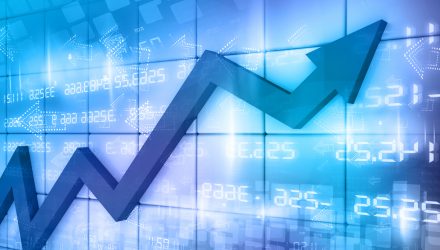Stocks and index ETFs are gaining back some of the considerable lost ground in September, in mixed Thursday trade, as investors absorb the most recent cluster of economic data, and markets attempt to recover from correction territory. .
The Dow Jones Industrial Average rose 134 points, or 0.53% after dropping as much as 226 points earlier in the session. The S&P 500 and Nasdaq Composite advanced 0.71% and 1%, respectively, after also showing losses near the open. Tech stocks like Apple, Microsoft, and Amazon helped fuel the run.
The major stock index ETFs are also attempting a run higher Thursday along with their underlying benchmarks, with the SPDR Dow Jones Industrial Average ETF (DIA), SPDR S&P 500 ETF Trust (SPY), and Invesco QQQ Trust (QQQ) all climbing as of 1230PM EST. The iShares Core S&P 500 ETF (IVV) gained over 0.79% Thursday as well.
Traders were likely disappointed by first-time state unemployment claims benefits, which reached 870,000 for the week ending Sept. 19, and beat a Dow Jones estimate of 850,000. Continuing claims declined somewhat meanwhile, remaining above projections nevertheless.
“Claims, arguable the most important high frequency data point currently, missed expectations and moved up week-over-week,” Evercore ISI strategist Dennis DeBusschere, said in a note Thursday. “With the Fed diminishing its own credibility by continually emphasizing the ineffectiveness of monetary policy and begging for fiscal support, weaker data will have a big impact on risk assets. Especially if the fiscal cliff starts to bite, which some indicators suggests might be starting.”
“People are getting concerned about what kind of economic recovery we’re going to get in the next few months,” said Megan Horneman, director of portfolio strategy at Verdence Capital Advisors. “Some parts of the economy are doing well and some are slowing down a bit.”
Still, traders and investors are irked by the lack of new fiscal stimulus, which several economists and the Federal Reserve claim is crucial for the economic recovery to persist, and led banks like Goldman Sachs to revise its fourth-quarter GDP projection to 3% from 6% on an annualized basis.
“We think it is now clear that Congress will not attach additional fiscal stimulus to the continuing resolution,” Jan Hatzius, chief economist at Goldman Sachs, wrote in a note. “This implies that after a final round of extra unemployment benefits that is currently being disbursed, any further fiscal support will likely have to wait until 2021.”
In September alone, the S&P 500 has fallen 7.5%, while the Dow lost 5.8%. The Nasdaq Composite meanwhile, has been beaten down 9.7% as investors rotate out of the key tech stocks that supported the run-up from March.
“Psychology around [tech]shifted and it’s no longer the stalwart source of support it once was. Meanwhile, investors still aren’t comfortable enough with the cyclical/value stocks to even begin to offset the ongoing tech weakness,” wrote Adam Crisafulli of Vital Knowledge.
For more market trends, visit ETF Trends.
